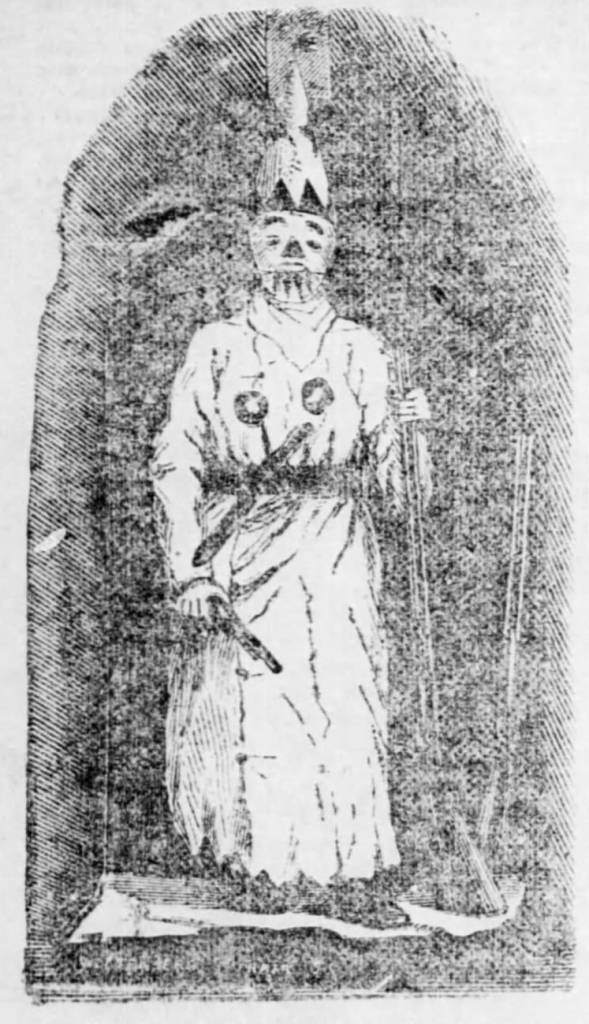The currently popular origin story of the Order of the Veiled Prophet describes the organization as a reaction by the St. Louis establishment to the labor turmoil of 1877. The Veiled Prophet was racist, elitist, secretive and maybe even violent.
Exhibit A has been an illustration of the very first Veiled Prophet, published by the St. Louis Republican on Oct. 6, 1878, two days before the organization’s first-ever parade.
The image, a wood engraving based on a photo, depicts a figure wearing a pointy hood and robes, with a shotgun, pistol and knife. It’s resurfaced in various contemporary media, especially whenever the Veiled Prophet becomes part of a narrative describing the systemic racism that has stunted St. Louis.
• For example, it was used by The Atlantic in September 2014, just weeks after the nation’s attention was focused on Ferguson: “The image of the first Veiled Prophet is armed with a shotgun and pistol and is strikingly similar in appearance to a Klansman.”
• Harvard historian Walter Johnson reproduced the image in his 2020 book about St. Louis’ racial history: “Clad in a white hood and robes, the ‘Veiled Prophet’ first patrolled the streets of St. Louis on the night of October 5, 1878, a revolver in one hand, a rifle in the other, a bowie knife looped through his belt.” (The parade was on Oct. 8.)
• Another writer explored the subject in July 2021 in The Nation, and again in May 2022 in something called Protean, a mostly online magazine: “In 1878, an engraving depicting a version of the Veiled Prophet character ran in St. Louis’s Missouri Republican newspaper — a publication sympathetic to the Confederacy.” (The newspaper opposed secession.)
The problem, writes George Garrigues, with these and many other accounts is the image used by the St. Louis Republican was, essentially, a joke.
Garrigues, a retired (and now deceased) journalist and academic, hunted down the original article published by the newspaper, and saw it was a lengthy and fanciful satire, replete with poetry (some in German) and illustrated with multiple images — including a ‘monster,’ the goddess Hebe, a roc’s egg, a giant fish (meant to depict Jonah and the whale), eyeglasses and what looked like a whisky bottle. All of these images had been published before, sometimes to accompany advertisements.
In fact — and this is the most extraordinary discovery by Garrigues — the image of the supposed hooded and robed Veiled Prophet first appeared on Aug. 23, 1875 to accompany a story about Klan activities in southern Illinois. And that image itself had been staged, which Garrigues explains in some detail in his 2022 book (his last), “The Failed Joke of the Veiled Prophet.”
None of this, of course, absolves the Veiled Prophet from accusations that it was racist and exclusionary. There’s ample evidence. But Garrigues suggests that many of the creation stories are riddled with mistakes — the sort of mistakes that happen when people rely on unreliable or secondary sources.
Garrigues devoted his retirement years to exploring old newspaper stories and personalities — his book about pioneer Post-Dispatch writer and illustrator Marguerite Martyn caught my eye in 2019. I didn’t know about the Veiled Prophet book, though, until this week. (I explored the pile of review books that resurfaced in the latest newsroom move while waiting for a couple writers to file.)
Garrigues had mailed his book to reporter Rachel Rice in June 2022. Unfortunately, Rachel — who wrote our story about actress Ellie Kemper apologizing for being named a “Queen of Love and Beauty” at the Veiled Prophet Ball in 1999 — left the paper in 2021, and his book landed in a pile of unread books. Garrigues died in August 2022. (Originally posted on Oct. 7, 2023)

